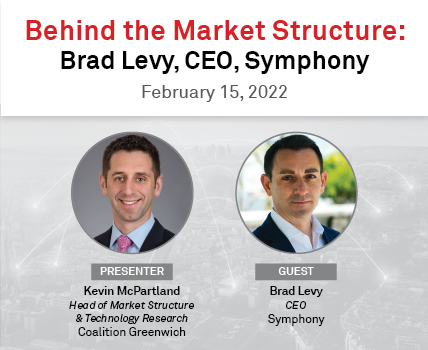Behind the Market Structure
An Interview with Sympony CEO Brad Levy
Q1 2022

“The collaboration economy is real,” says Brad Levy, CEO, Symphony, a financial markets collaboration and workflow platform, in a February 2022 interview with Kevin McPartland, Head of Research for the Market Structure and Technology group at Coalition Greenwich.
“I think of things in cycles all the time,” says Brad Levy, who has been involved in financial markets since 1992. Brad sees the years following the global financial crisis as the “dark years of innovation,” with the market focused on regulatory change. 2015 then kicked off the birth of many new fintech firms. “We’re now coming into a phase of consolidation. By 2025, I think a lot of the table will be set,” he says.
Partnering to Win
According to Brad, acquiring firms is a carefully honed art.
“There's a playbook there. You have to be really careful to buy things that make sense. You can go through the, ‘I'm going to combine two competitors and take the cost out.’ But the reality is, when you're doing new things, there are not a lot of competitors as much as complementers. And the question is, how do you take those things and put them on a bigger platform? That’s what Symphony is going to do.”
He adds, “I think partnerships are a much bigger deal now than they ever have been. You have to partner to win, and these partnerships may become consolidation plays down the road as they get tighter.”
Such co-opetition calls for open architecture. For instance, since many market participants want Zoom for videoconferencing, Symphony has integrated it as a front-facing service on its own platform. “We’ll have other such integrations coming,” he reveals.
“We’re partnering with the fintechs, the mega-techs and Tech4Fins, for instance, in the distributed ledger technology space. I've always believed in co-opetition. There's a way to do that, which is additive—when you quilt things, you need that 20% overlap to make it sturdy, but it's that 20% overlap that sometimes creates the friction and challenge of cooperating,” he explains.
Getting Integrations Right
As for what makes deals work, the people dynamic is crucial, according to Brad Levy. “You must have a really good vision going in strategically, get the ‘people side’ right, the integrations right, and make sure that you're messaging very clearly to the market on why you're doing it and where you are in the cycle,” he says.
Symphony, he believes, has managed to do that with Cloud9 and StreetLinx. With Cloud9, Symphony now has two networks: its own collaboration network and Cloud9’s trader voice telephony platform. Both address different segments. “We're not slamming the platforms together as much as making sure they can talk easily, making it seamless from a user perspective,” he says.
How is the collaboration economy changing things on the ground? Undoubtedly, social networks such as Zoom, WhatsApp and Telegram are all impactful. “But they’re not compliant from my clients’ perspectives. We would love for everyone to be chatting on Symphony in a highly secure network, but that's not the way it works anymore. So now we have federation technologies that allow us to get WhatsApp, WeChat and SMS integrated from a Symphony user perspective,” he says.
Looking Ahead: Quantum
There are challenges ahead too, both regulatory and technological. Quantum computing, for instance, could be revolutionary and disruptive.
“Over the next five years, there will real applications in quantum. I would say by 2030, it will be in our lives in enough ways that, because of the speed increase and detachment from what we think is secure from the chip up, we will have to think about encryption and security in a completely different way soon. We are an encrypted, secure platform and, as an industry, it's something that we will have to give some real thought to in a couple of years,” predicts Brad Levy.

